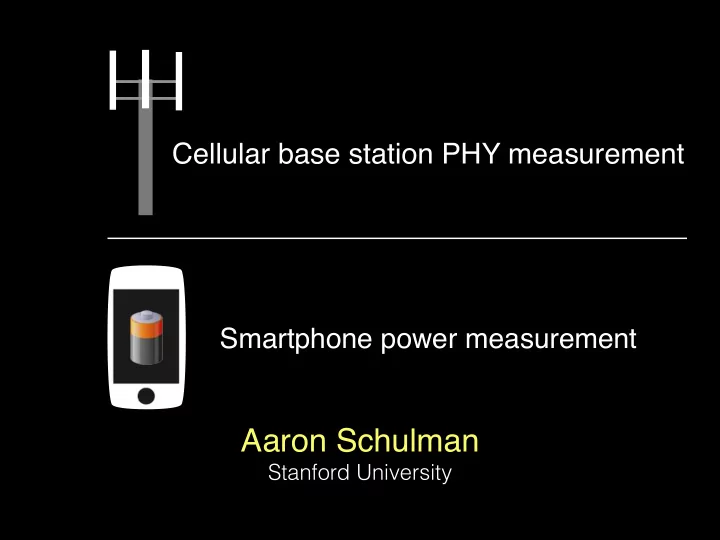

Cellular base station PHY measurement Smartphone power measurement Aaron Schulman Stanford University
Cellular base station PHY measurement Smartphone power measurement Aaron Schulman Stanford University
Why measure the PHY of cellular base stations? To quantify the pervasiveness of PHY faults: How often are frames dropped due to inter-cell interference? To identify and adapt to challenging PHY environments: Can we observe high delay spread and adjust to compensate?
Why measure the PHY of cellular base stations? To quantify the pervasiveness of PHY faults: How often are frames dropped due to inter-cell interference? To identify and adapt to challenging PHY environments: Can we observe high delay spread and adjust to compensate? To inform the design and deployment of future standards
An Opportunity! Programmable DSPs Example: TI 6678 - 8 DSP cores @ 1GHz ANSI C - 4 ARM cores @ 1GHz - Many co-processors
Cellular requirements make it challenging to add new measurements LTE UL PHY (eNB) Re#TX& HARQ& 3 ms latency Resource& Mapping& 20 MHz bandwidth MCS& Combining& MIMO$ High reliability
Cellular requirements make it Low DSP clock rates make it challenging to add new measurements LTE UL PHY (eNB) Re#TX& HARQ& 3 ms latency Resource& Mapping& ~2,000 cycles 20 MHz bandwidth MCS& per byte Combining& MIMO$ 25 cycles per sample High reliability Can not exceed cycle budget
Atom Composable processing block that requires fixed processing resources 48 bits 48 cplx BPSK48 Atom = ¡200 ¡cycles
Atom Composable processing block that requires fixed processing resources 48 bits 48 cplx BPSK48 Atom = ¡200 ¡cycles Entire base station PHY can be made of Atoms We built a 54 Mbps 802.11a receiver entirely out of Atoms
Atom Composable processing block that requires fixed processing resources 48 bits 48 cplx BPSK48 Atom = ¡200 ¡cycles Entire base station PHY can be made of Atoms We built a 54 Mbps 802.11a receiver entirely out of Atoms New measurements are just new Atoms We added a delay spread measurement Atom
Atom Composable processing block that requires fixed processing resources 48 bits 48 cplx BPSK48 Atom = ¡200 ¡cycles Entire base station PHY can be made of Atoms We built a 54 Mbps 802.11a receiver entirely out of Atoms New measurements are just new Atoms We added a delay spread measurement Atom New measurements can be deployed on Atom-based base stations
Cellular base station PHY measurement Smartphone power measurement
Cellular base station PHY measurement Smartphone power measurement
Why measure smartphone power? To create models of energy consumption: Are apps using hardware inefficiently? Do users use apps in a way that wastes energy? To inform developers about app energy consumption: Did a code change harm energy consumption?
Why measure smartphone power? To create models of energy consumption: Are apps using hardware inefficiently? Do users use apps in a way that wastes energy? To inform developers about app energy consumption: Did a code change harm energy consumption? To find new ways to improve smartphone battery life
Properties of an ideal smartphone power monitor Passive Scalable Mobile Universal
Properties of an ideal smartphone power monitor Passive Scalable Mobile Universal No existing power monitor has all 5 properties
BattOr - The ideal smartphone power monitor Passive Scalable Mobile Universal
BattOr - The ideal smartphone power monitor Passive Scalable Mobile Universal
BattOr - The ideal smartphone power monitor Passive Scalable Mobile Universal $200 each
BattOr - The ideal smartphone power monitor Passive Scalable Mobile Universal $200 3.5cm each 3.5cm
BattOr - The ideal smartphone power monitor Passive Scalable Mobile Universal $200 3.5cm each 3.5cm
Conclusion It is feasible to deploy new measurements on cellular base stations. An ideal smartphone power monitor is obtainable.
Recommend
More recommend